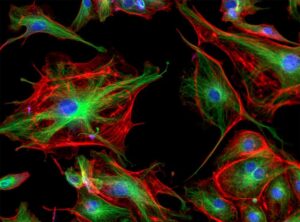
This paradigm shift prompted a recent exploration into a groundbreaking biochemical pathway that intricately regulates aging. Researchers, working with Caenorhabditis elegans worms, uncovered a pathway based on signals exchanged among mitochondria, the cellular powerhouses. The study revealed that when mitochondria in brain cells sustained damage, a robust repair response was triggered and subsequently amplified. Astonishingly, this repair activity extended the life span of the worms by a remarkable 50%. What added a new layer to this discovery was the pivotal role played by cells in the germline, responsible for egg and sperm production, in facilitating this anti-aging communication system.
Building upon recent findings suggesting that mitochondria act as social organelles capable of communicating across different tissues, this research delves into the intricate dialogue between these cellular powerhouses. Mitochondria, akin to cellular walkie-talkies, emerged as messengers influencing the survival and life span of the entire organism. The unexpected revelation that defective mitochondria in the nervous system could lead to longer life challenged conventional assumptions, pointing to the vital importance of certain mitochondria in driving this anti-aging effect. Moreover, the study uncovered that mitochondria in stressed neurons communicated repair signals to other cells in the body via vesicles, revealing a fascinating cellular mechanism that extends life by maintaining cellular health. This research not only sheds light on the complexity of aging at the molecular level but also underscores the importance of intercellular communication in the quest to understand and potentially manipulate the aging process.
Mitochondria: Beyond Energy Producers to Cellular Messengers
Recent studies have thrust mitochondria into the spotlight, not just as energy powerhouses but as cellular messengers. The powerhouse organelles are now recognized as participants in a biochemical pathway regulating aging. Experiments with worms showcased a fascinating connection: damage to mitochondria in brain cells triggered a repair response, extending the organism’s life span by an astonishing 50%. The significance of this repair activity echoed beyond individual cells, encompassing the entire organism.
Germline Cells: Orchestrators of Anti-Aging Signals
Adding a nuanced layer to discussions about fertility and aging, this research brings forth the intriguing revelation that cells in the germline, responsible for producing eggs and sperm, play a central role in the anti-aging communication system. Traditionally associated with reproductive functions, germline cells have now taken center stage in influencing the overall life span of the organism. This discovery not only underscores the interconnectedness of reproductive health and the aging process but also opens avenues for exploring the intricate ways in which signals from these cells contribute to the broader regulation of life span. As scientists delve deeper into understanding the molecular intricacies of aging, the spotlight on germline cells adds a new dimension to our comprehension of the factors influencing longevity and prompts a reevaluation of the relationship between fertility and the broader aging phenomenon.
Mitochondrial Chatter: A Symphony Across Tissues
Mitochondria, once perceived solely as energy producers, are now acknowledged as social organelles capable of inter-tissue communication. This revelation has unveiled a new dimension to our understanding of aging regulation—a dynamic conversation occurring beyond genetic programs. The transmission of messages between mitochondria throughout the body influences the survival and life span of the organism, marking a departure from conventional perspectives.
The Unfolded Protein Response: Cellular Mechanism of Repair
A decade ago, the landscape of aging research underwent a transformative shift when cell biologist Andrew Dillin unraveled a life-extending pathway in worms. The conventional wisdom would have predicted that genetically damaging mitochondria, the energy powerhouses of cells, would hasten the demise of these organisms. However, the unexpected outcome defied expectations, revealing that such damage induced worms to live significantly longer. In the quest to decipher the cellular intricacies behind this phenomenon, scientists pinpointed the unfolded protein response, a stress response mechanism triggered by damaged mitochondria. This unfolded protein response, akin to a meticulous maintenance regimen, emerged as a cellular repair mechanism crucial for ensuring the overall health of cells. The revelation of this intricate cellular pathway not only challenged conventional notions but also paved the way for a deeper understanding of how cellular repair processes contribute to longevity.
Wnt Signaling: A Cellular Relay System Unveiled
As researchers explored the communication channels, they identified vesicles as messengers transmitting the unfolded protein response beyond nerve cells. These vesicles carried a signal called Wnt, a surprising discovery that unveiled a cellular relay system. Further investigations uncovered a gene expressed exclusively in the mitochondria of the germline, interrupting Wnt signaling and implicating germline cells as vital contributors to the communication network.
Age-Related Decline: The Germline Connection
The strength of the germline signal emerged as a critical determinant of an organism’s life span. As worms age, the declining quality of their eggs or sperm corresponded to a diminished ability to transmit signals from the brain’s mitochondria. This intricate connection highlighted the ticking of a biological clock, reflected in the waning effectiveness of the germline’s repair signal with age.
Implications for Humans: Evolutionary Perspectives Unveiled
While the direct applicability to humans remains uncertain, the hypothesis aligns with evolutionary logic. The health of germ cells appears pivotal in signaling pro-survival measures, ensuring the survival of the host organism for reproduction. As germ cell quality declines, there seems to be little evolutionary incentive to extend life span further. The intricate mitochondrial conversations, echoing their free-living bacterial ancestry, might unlock the secrets of aging in more complex organisms like humans.
Intriguingly, within our cells, the mitochondria may be engaged in a profound conversation about the intricacies of our age, offering a fresh perspective on the captivating journey of aging from a cellular standpoint.
Conclusion: Deciphering the Mitochondrial Dialogue
In unraveling the intricate language of aging, the newfound insights into mitochondrial conversations redefine our understanding of this complex biological process. Mitochondria, once mere energy producers, emerge as cellular messengers orchestrating anti-aging signals. The germline takes center stage, playing a pivotal role in transmitting these signals and influencing the overall life span of an organism. As we explore this dynamic interplay, the implications for human aging remain a tantalizing prospect, offering potential keys to unlocking the secrets of longevity. The cellular symphony of mitochondria unveils a profound conversation within our bodies, reminding us that the aging process may hold the key to a deeper understanding of life itself.

Related Topics:
- The Impact of Technology on Physical and Mental Health – Micro2media.com
- Walk Your Way to Wellness: How Picking Up the Pace Can Lower Your Diabetes Risk – Micro2media.com
- Treatment Corrects Consequences of Accelerated Cellular Aging | NIH Intramural Research Program
- Exploring Cellular Senescence: Defining Cell Morphology, Aging & Cell Division – Assay Genie
